Virtualized Evolved Packet Core (vEPC) Market by Offering (Solutions and Services (Professional and Managed)), Deployment Model (Cloud, On-premises), Network Typ (4G and 5G), End User (Telecom Operators, Enterprises) and Region - Global Forecast to 2028
[286 Pages Report] The global vEPC market is USD 8.4 billion for the year 2023 and is expected to be worth USD 19.9 billion by 2028, growing at a CAGR of 18.7% during the forecast period. The rapid growth of mobile data traffic and the increasing number of connected devices create a demand for highly scalable and efficient network infrastructure. vEPC offers the flexibility and agility needed to handle this surge in data traffic and support the seamless connectivity of numerous devices.
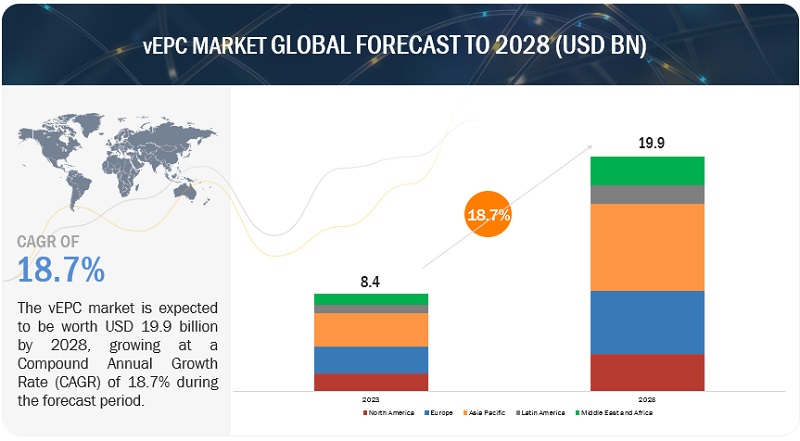
To know about the assumptions considered for the study, Request for Free Sample Report
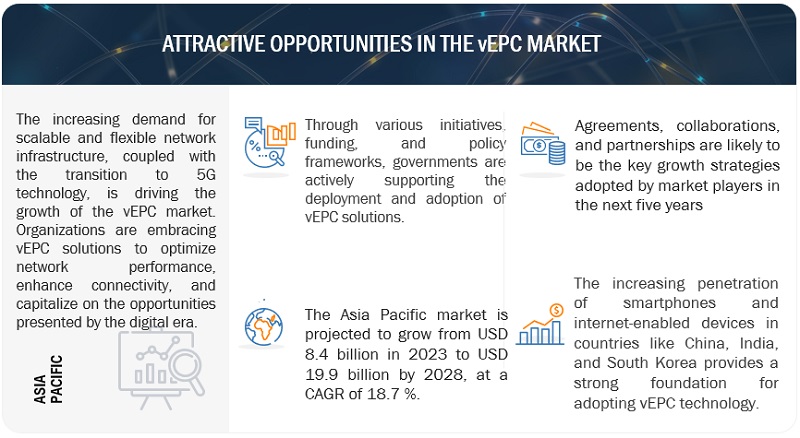
To know about the assumptions considered for the study, download the pdf brochure
vEPC Market Dynamics
Driver: Increasing Demand for High-Speed and Reliable Connectivity
The growing adoption of data-intensive applications and emerging technologies like the Internet of Things (IoT) and 5G has created a significant demand for high-speed and reliable connectivity. Businesses and consumers require seamless connectivity to support bandwidth-intensive activities such as video streaming, online gaming, and real-time data transmission. vEPC solutions are crucial in meeting this demand by offering virtualized Evolved Packet Core functionality. These solutions provide efficient network management, scalability, and flexibility, enabling service providers to deliver fast and reliable customer connectivity.
Restraint: Complexity and Cost of Implementation and Management
Implementing and managing virtualized network infrastructure, including vEPC solutions, can be complex and costly for organizations. The deployment of vEPC requires skilled professionals who possess expertise in virtualization, network management, and security. Additionally, organizations need to invest in robust IT systems and infrastructure to support the virtualized environment. The complexity and cost of implementation and management can act as barriers to entry for smaller organizations or those with limited resources. Furthermore, data security and privacy concerns need to be effectively addressed to ensure the widespread adoption of vEPC solutions.
Opportunity: Adoption of Cloud Computing and Virtualization Technologies
The increasing adoption of cloud computing and virtualization technologies presents a significant opportunity for the vEPC market. Cloud-based vEPC deployments offer scalability, cost-efficiency, and easier management than traditional hardware-based solutions. By leveraging cloud infrastructure, organizations can dynamically scale their network resources based on demand, reducing operational costs and increasing flexibility. Additionally, virtualization technologies enable the decoupling of software from hardware, allowing for efficient resource utilization and simplified network management. Integrating vEPC with cloud computing and virtualization technologies opens up new possibilities for network optimization, service delivery, and enhanced user experiences.
Challenge: Interoperability and Standardization
Interoperability and standardization are major challenges in the vEPC market. As multiple vendors offer vEPC solutions, ensuring seamless interoperability between different components and networks becomes crucial. The lack of interoperability can lead to compatibility issues and limit the scalability of vEPC deployments. Additionally, the absence of standardized protocols and interfaces hinders the smooth integration of vEPC with other network elements and technologies. Establishing industry-wide standards and protocols for vEPC will promote interoperability, simplify deployment, and enhance the overall efficiency of virtualized networks.
vEPC Market Ecosystem
The vEPC market is driven by prominent companies that have established themselves as leaders in the industry. These companies are well-established, financially stable, and have a proven track record in providing innovative solutions and services in the telecommunications sector. Their diverse product portfolio spans infrastructure, devices, applications, and services, enabling them to cater to the market's evolving needs. With state-of-the-art technologies and extensive research and development capabilities, these companies are at the forefront of driving the advancement of vEPC technology.
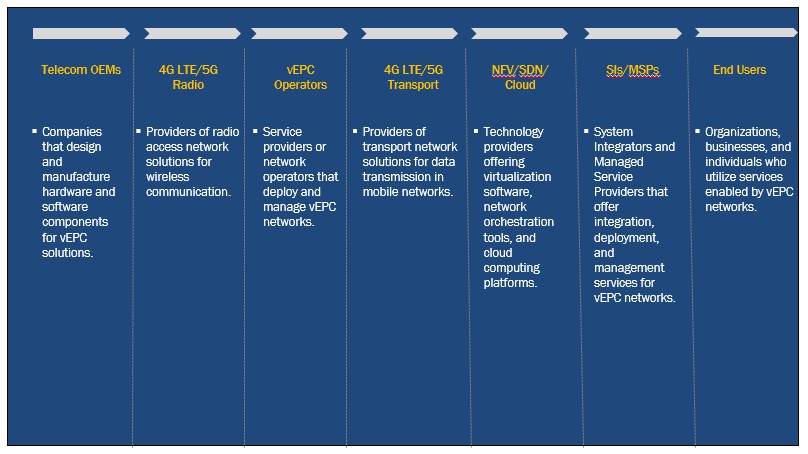
By offering, services segment to grow at a higher CAGR during the forecast period
As organizations increasingly adopt virtualized evolved packet core solutions, they require a range of services to support their deployment and operation. These services encompass consulting, system integration, customization, training, and ongoing technical support. With the complex nature of vEPC implementations and the need for seamless integration with existing network infrastructure, businesses rely on service providers to ensure a smooth transition and optimal performance.
By network type, the 5G network segment is expected to grow at a higher CAGR during the forecast period
With the rapid adoption of 5G technology worldwide, there is a surge in demand for virtualized evolved packet core (vEPC) solutions to support the advanced capabilities of 5G networks. The 5G network segment offers unprecedented speed, ultra-low latency, and massive device connectivity, enabling transformative applications across industries. As businesses and consumers increasingly embrace the benefits of 5G, the demand for vEPC solutions tailored for 5G networks is expected to witness substantial growth, driving the overall expansion of the vEPC market.
By region, Asia Pacific to grow at a higher CAGR during the forecast period
With its large population, rapid digital transformation, and increasing smartphone penetration, the region presents immense opportunities to adopt virtualized evolved packet core (vEPC) solutions. The Asia Pacific countries are actively investing in deploying 5G networks, driving the demand for vEPC infrastructure to support the next generation of wireless communication. Additionally, the region is witnessing the emergence of innovative applications and services that leverage the capabilities of vEPC, such as smart cities, industrial automation, and IoT deployments.
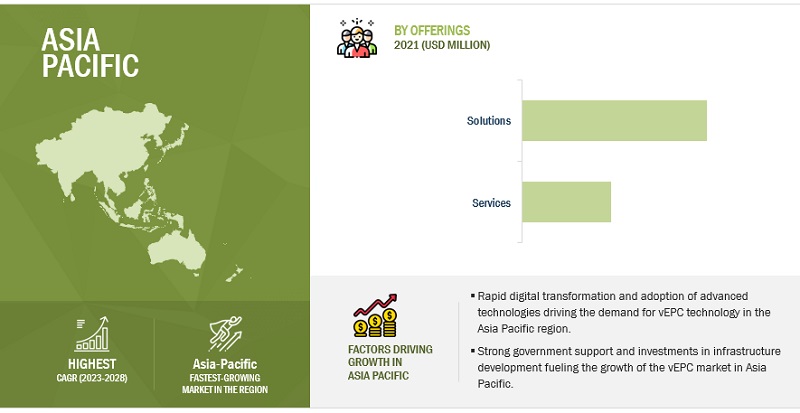
Market Players:
The major players in the vEPC market are Nokia (Finland), Ericsson (Sweden), Cisco(US), Huawei (China), ZTE (China), Samsung (South Korea), Affirmed Networks(US), Mavenir(US), NEC(Japan), Athonet(Italy), Cumucore(Finland), Druid Software(Ireland), IPLook (China), Tech Mahindra (India), Parallel Wireless (US), Polaris Networks (US), Xingtera (US), Lemko (US), Tecore(US), and Telrad Networks (Israel). These players have adopted various growth strategies, such as partnerships, agreements and collaborations, product launches and enhancements, and acquisitions to expand their footprint in the vEPC market.
Get online access to the report on the World's First Market Intelligence Cloud
- Easy to Download Historical Data & Forecast Numbers
- Company Analysis Dashboard for high growth potential opportunities
- Research Analyst Access for customization & queries
- Competitor Analysis with Interactive dashboard
- Latest News, Updates & Trend analysis
Request Sample Scope of the Report
Get online access to the report on the World's First Market Intelligence Cloud
- Easy to Download Historical Data & Forecast Numbers
- Company Analysis Dashboard for high growth potential opportunities
- Research Analyst Access for customization & queries
- Competitor Analysis with Interactive dashboard
- Latest News, Updates & Trend analysis
|
Report Metrics |
Details |
|
Market size available for years |
2023-2028 |
|
Base year considered |
2022 |
|
Forecast period |
2023-2028 |
|
Forecast units |
Value (USD) Million/Billion |
|
Segments Covered |
Offering, solutions, services, network, deployment model, end-user, application, and regions |
|
Region covered |
North America, Europe, Asia Pacific, Middle East and Africa, and Latin America |
|
Companies covered |
Nokia (Finland), Ericsson (Sweden), Cisco(US), Huawei (China), ZTE (China), Samsung (South Korea), Affirmed Networks(US), Mavenir(US), NEC(Japan), Athonet(Italy), Cumcore(Finland), Druid Software(Ireland), IPLook (China), Tech Mahindra (India), Parallel Wireless (US), Polaris Networks (US), Xingtera (US), Lemko (US), Tecore(US), and Telrad Networks (Israel). |
This research report categorizes the vEPC market to forecast revenues and analyze trends in each of the following submarkets:
Based on Offering:
- Solutions
- Services
Based on Solution:
- MME
- HSS
- S-GW
- PDN-GW
Based on Services:
- Professional Services
- Consulting
- Integration and Deployment
- Training and Support
- Managed Services
Based on Network
- 5G Network
- 4G Network
Based on End user:
- Telecom operators
- Enterprises
Based on Deployment mode:
- Cloud
- On-Premises
Based on Region:
-
North America
- US
- Canada
-
Europe
- UK
- Germany
- Italy
- France
- Spain
- Rest of Europe
-
Asia Pacific
- China
- Japan
- Australia
- South Korea
- Rest Of Asia Pacific
-
Middle East and Africa
- KSA
- UAE
- South Africa
- Rest of Middle East & Africa
-
Latin America
- Brazil
- Mexico
- Rest of Latin America
Recent Developments
- October 2022 - To support the development of 5G ecosystems and advance 6G research in Europe, the Smart Networks and Services Joint Undertaking (SNS JU) has chosen its initial portfolio of 35 research, innovation, and trial projects. The goal is to create a world-class European supply chain for cutting-edge 5G systems and expand Europe's 6G technology capacities with total funding for this new portfolio of about €250 million under Horizon Europe.
- September 2022 - Nokia announced its Software-as-a-Service (SaaS), AVA Charging, to support CSPs and enterprises to quickly commercialize new offerings for 5G and IoT use cases.
- October 2021 - The company launched a new set of 5G solutions to enable the evolution of all frequency bands to 5G.
- May 2019 - Ericsson cloud packet core will be employed by Vodafone Idea Limited to improve network performance. Ericsson's major network applications and features, like its Virtualization Infrastructure (NFVI), Service-Aware Policy Controller (VSAPC), and Virtual Evolved Packet Gateway (VEG) solutions, which facilitate seamless business continuity and quick rollout of new services, will be advantageous to VIL.
Frequently Asked Questions (FAQ):
What is vEPC?
vEPC, or virtual Evolved Packet Core, is a software-based implementation of the Evolved Packet Core (EPC) used in mobile networks. It replaces the traditional hardware-based EPC with virtualized network functions (VNFs) that run on standard servers or cloud infrastructure. This virtualization brings increased flexibility, scalability, and cost-efficiency to mobile network operations. vEPC enables network operators to allocate resources dynamically, scale their networks as needed, and introduce new services and applications quickly.
What is the market size of the vEPC market?
MarketsandMarkets forecasts the vEPC market size from USD 8.4 billion in 2023 to USD 19.9 billion by 2028 at a Compound Annual Growth Rate (CAGR) of 18.7% during the forecast period.
What are the major drivers in the vEPC market?
The vEPC market is driven by the increasing demand for high-speed and reliable mobile data services, fueled by the exponential growth in data consumption and bandwidth-intensive applications. The adoption of advanced technologies such as 5G and IoT further contributes to the demand for vEPC, as it enables the deployment of these technologies with the necessary infrastructure. Cost-efficiency and scalability are additional drivers, as virtualizing network functions reduces expenses and allows for flexible resource allocation. The focus on network virtualization and SDN also drives the demand for vEPC solutions, providing operators with agility and flexibility in network operations. These drivers collectively shape the vEPC market, meeting the evolving needs of mobile networks in the digital era.
Who are the major players operating in the vEPC market?
The major players in the vEPC market are Nokia (Finland), Ericsson (Sweden), Cisco(US), Huawei (China), ZTE (China), Samsung (South Korea), Affirmed Networks(US), Mavenir(US), NEC(Japan), Athonet(Italy), Cumucore(Finland), Druid Software(Ireland), IPLook (China), Tech Mahindra (India), Parallel Wireless (US), Polaris Networks (US), Xingtera (US), Lemko (US), Tecore(US), and Telrad Networks (Israel).
Which are the key technology trends prevailing in the vEPC market?
With the increasing demand for higher data speeds, lower latency, and massive connectivity, vEPC solutions are being designed to support the requirements of 5G networks. Additionally, the integration of virtualization and software-defined networking (SDN) is another important trend. By leveraging virtualization technologies, vEPC deployments can achieve greater flexibility, scalability, and resource optimization. The convergence of vEPC with edge computing is also on the rise, enabling operators to deploy vEPC at the network edge for improved performance and reduced latency. Furthermore, the emphasis on security is a significant trend, with vEPC solutions incorporating advanced security measures to safeguard network assets and data.
To speak to our analyst for a discussion on the above findings, click Speak to Analyst
This research study involved extensive secondary sources, directories, and databases, such as D&B Hoovers and Bloomberg BusinessWeek, to identify and collect information useful for this technical, market-oriented, and commercial study of the global vEPC market. The primary sources were several industry experts from core and related industries and preferred suppliers, manufacturers, distributors, Service Providers (SPs), technology developers, alliances, and organizations related to all the segments of this industry’s value chain. In-depth interviews were conducted with various primary respondents, including key industry participants, subject-matter experts, C-level executives of key market players, and industry consultants to obtain and verify critical qualitative and quantitative information and assess prospects.
Secondary Research
In the secondary research process, various secondary sources were referred to identify and collect information for the study. These included journals, annual reports, press releases, investor presentations of companies and white papers, certified publications, and articles from recognized associations and government publishing sources. Secondary research was mainly used to obtain key information about industry insights, the market’s monetary chain, the overall pool of key players, market classification, and segmentation according to industry trends to the bottom-most level, regional markets, and key developments from both market and technology-oriented perspectives.
Primary Research
In the primary research process, various primary sources from both the supply and demand sides were interviewed to obtain qualitative and quantitative information for the report. The primary sources from the supply side included industry experts, such as Chief Executive Officers (CEOs), Chief Technology Officers (CTOs), Chief Operating Officers (COOs), Vice Presidents (VPs), marketing directors, technology and innovation directors, and related key executives from various companies and organizations operating in the vEPC market. The primary sources from the demand side included consultants/specialists, Chief Information Officers (CIOs), and subject-matter experts.
The Breakup of Primary Research:
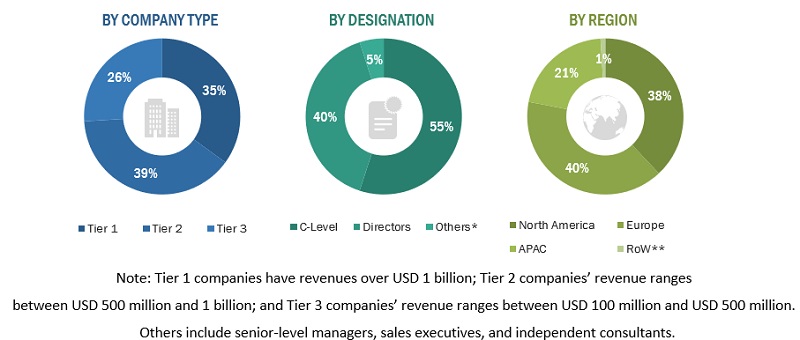
To know about the assumptions considered for the study, download the pdf brochure
Market Size Estimation
Multiple approaches were adopted to estimate and forecast the vEPC market. The first approach involved estimating the market size by summating companies’ and countries investments through vEPC solutions.
Both top-down and bottom-up approaches were used to estimate and validate the total size of the vEPC market. The research methodology used to estimate the market size includes the following:
- Key players in the market have been identified through extensive secondary research.
- In terms of value, the industry’s supply chain and market size have been determined through primary and secondary research processes.
- All percentage shares, splits, and breakups have been determined using secondary sources and verified through primary sources.
vEPC Market Size: Bottom-Up Approach
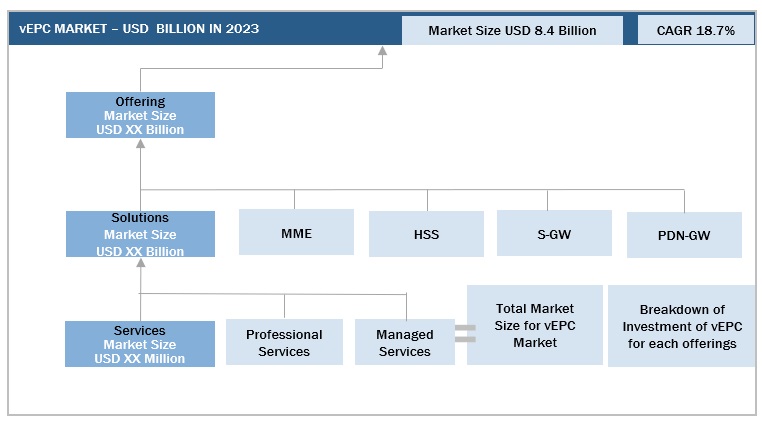
To know about the assumptions considered for the study, Request for Free Sample Report
vEPC Market Size: Top-Down Approach

Data Triangulation
The data triangulation procedures were used to complete the overall market engineering process and arrive at the exact statistics for all segments and subsegments. The data was triangulated by studying various factors and trends from the demand and supply sides. Along with data triangulation and market breakdown, the market size was validated by the top-down and bottom-up approaches.
Market Definition
vEPC, short for virtualized Evolved Packet Core, is a software-based network architecture that virtualizes the key functions of a traditional Evolved Packet Core (EPC) used in mobile networks. It is designed to provide the necessary packet switching, mobility management, and policy control functions to operate mobile networks efficiently. By virtualizing these functions, vEPC enables network operators to leverage cloud computing and virtualization technologies to achieve greater flexibility, scalability, and cost efficiency in deploying and managing their mobile networks. It allows for separating hardware and software, enabling network functions to be deployed on standard servers or cloud infrastructure.
Key Stakeholders
- Satellite Operators
- Mobile Operators
- Government Organizations
- Investors and Venture Capitalists
- Government and Financial Institutions
- Research Institutes and Organizations
Report Objectives
- To determine and forecast the global vEPC market based on offering, solutions, services, network, deployment model, end user, application and regions from 2023 to 2028.
- To forecast the size of the market’s segments with respect to five main regions: North America, Europe, Asia Pacific (APAC), Latin America, Middle East & Africa (MEA)
- To provide detailed information about the major factors (drivers, opportunities, threats, and challenges) influencing the growth of the market
- To study the complete value chain and related industry segments and perform a value chain analysis of the market landscape
- To strategically analyze macro and micromarkets with respect to individual growth trends, prospects, and contributions to the total market
- To analyze industry trends, regulatory landscape, and patents & innovations related to the market
- To analyze opportunities in the market for stakeholders by identifying the high-growth segments of the vEPC market
- To profile key players in the market and comprehensively analyze their market share/ranking and core competencies
- To track and analyze competitive developments, such as mergers and acquisitions, a new product launched and product developments, partnerships, agreements, and collaborations, business expansions, and Research & Development (R&D) activities, in the market
Available Customizations
With the given market data, MarketsandMarkets offers customizations as per the company’s specific needs. The following customization options are available for the report:
Company Information
- Detailed analysis and profiling of additional market players (up to 5)




 Generating Response ...
Generating Response ...







Growth opportunities and latent adjacency in Virtualized Evolved Packet Core (vEPC) Market